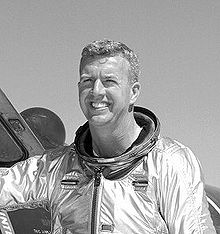
Summary
Flight 90 of the North American X-15 was a research flight conducted by NASA and the US Air Force on July 19, 1963. It was the first of two X-15 missions that passed the 100-km high Kármán line, the FAI definition of space, along with Flight 91 the next month. The X-15 was flown by Joseph A. Walker, who flew both X-15 spaceflights over the Kármán line.
| Mission type | Test flight |
|---|---|
| Operator | US Air Force/NASA |
| Mission duration | 11 minutes, 24 seconds |
| Distance travelled | 534 kilometers (332 mi) |
| Apogee | 106.01 kilometers (65.87 mi) |
| Spacecraft properties | |
| Spacecraft | X-15 |
| Manufacturer | North American |
| Launch mass | 15,195 kilograms (33,499 lb) |
| Landing mass | 6,260 kilograms (13,800 lb) |
| Dry mass | 6,577 kilograms (14,500 lb) |
| Crew | |
| Crew size | 1 |
| Members | Joseph A. Walker |
| Start of mission | |
| Launch date | July 19, 1963, 18:20:05 UTC |
| Launch site | Balls 8, Edwards Dropped over Smith Ranch Dry Lake 39°20′N 117°29′W / 39.333°N 117.483°W |
| End of mission | |
| Landing date | July 19, 1963, 18:31:29.1 UTC |
| Landing site | Rogers Dry Lake, Edwards |
 X-15 Flight 90 pilot, Joe Walker | |
Crew edit
| Position | Astronaut | |
|---|---|---|
| Pilot | Joseph A. Walker First (FAI-recognized) / Second (U.S.-recognized) spaceflight | |
Mission parameters edit
- Mass: 15,195 kg fueled; 6,577 kg burnout; 6,260 kg landed
- Maximum Altitude: 106.01 km., 347,800 feet
- Range: 534 km
- Burn Time: 84.6 seconds
- Mach: 5.50
- Launch Vehicle: NB-52B Bomber #008
Mission highlights edit
Maximum Speed - 5,971 km/h. Maximum Altitude - 106,010 m. 80 cm diameter balloon towed on 30 m line to measure air density. First X-15 flight over 100 km (a height known as the Kármán line). This made Walker the first US civilian in space.[1] This was also the first spaceflight of a spaceplane in aviation history. First flight launched over Smith Dry Lake, NV. Experiments: Towed balloon, horizon scanner, photometer, infrared and ultraviolet. Balloon instrumentation failed.
The mission was flown by X-15 #3, serial 56–6672 on its 21st flight.
Launched by: NB-52B #008, Pilots Fulton & Bement. Takeoff: 17:19. UTC Landing: 19:04 UTC.
Chase pilots: Crews, Dana, Rogers, Daniel and Wood.
The X-15 engine burned about 85 seconds. Near the end of the burn, acceleration built up to about 4g (39 m/s²). Weightlessness lasted for 3 to 5 minutes. Re-entry heating warmed the exterior of the X-15 to 650 °C in places. During pull up after re-entry, the acceleration built up to 5g (49 m/s²) for 20 seconds. The entire flight lasted about 12 minutes from launch to landing.
Notes edit
- ^ Evans, Larry (November 27, 2006). "Higher & Faster: Memorial Fund Established for X-15 pilot". TechMediaNetwork. Space.com. Retrieved May 4, 2010.
References edit
- Goodwin, Robert (2000). X-15: the NASA mission reports, incorporating files from the USAF. Burlington, Ontario: Apogee Books. ISBN 1-896522-65-3.
- Jenkins, Dennis R. (2000), Hypersonics Before the Shuttle: A Concise History of the X-15 Research Airplane, NASA Technical Reports, NASA, hdl:2060/20000068530, Document ID: 20000068530
- Price, A. B. (1968), Thermal protection system X-15A-2 Design Report, NASA Technical Reports, NASA, hdl:2060/19680016245, Document ID: 19680016245
- Stillwell, W. H. (1965), X-15 research results with a selected bibliography, NASA Technical Reports, NASA, hdl:2060/19650010561, Document ID: 19650010561
- Watts, Joe D. (1968), Flight experience with shock impingement and interference heating on the X-15-2 research airplane, NASA Technical Reports, NASA, hdl:2060/19920075739, Document ID: 19920075739


